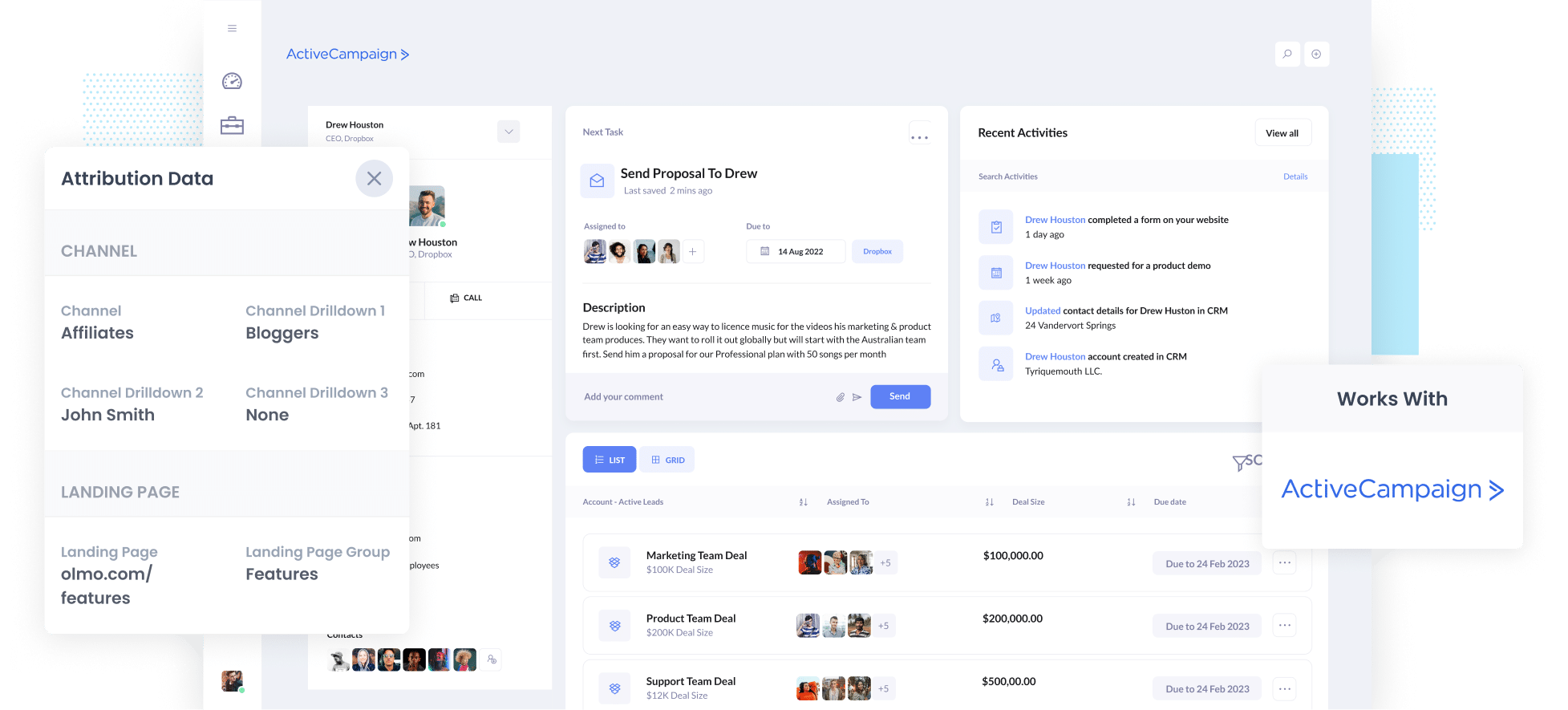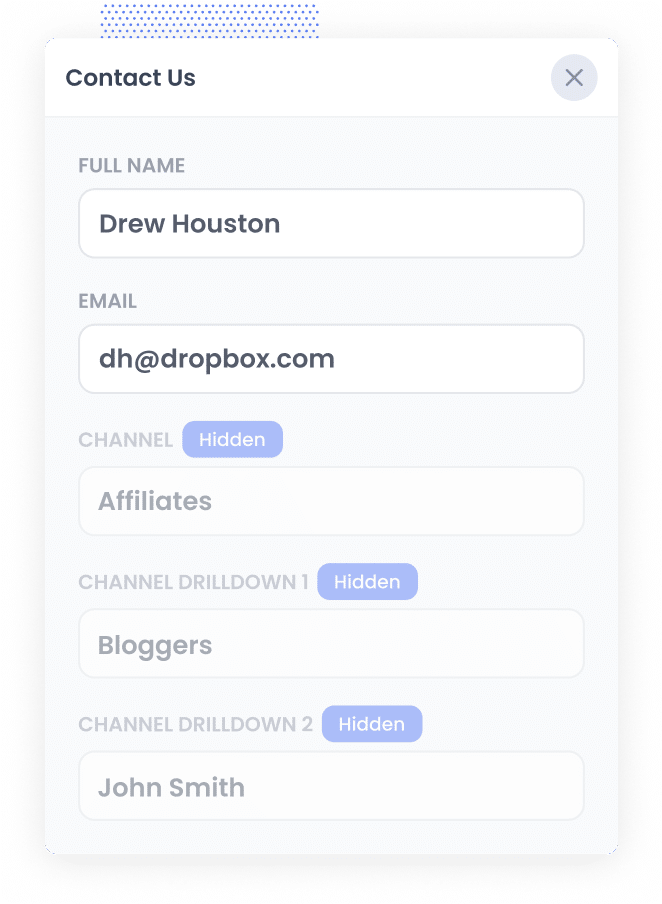Track how many leads you get from Affiliates in ActiveCampaign
Here's how to track how many leads and customers you get from Affiliates in ActiveCampaign

Are you finding it tricky to track how many leads and customers you're getting from your affiliate program?
Lacking this essential piece of information could lead to your marketing dollars being spent on campaigns that don't work out.
However, there is a solution.
In this article, we will walk you through how to use Attributer to capture vital data about Affiliates right in ActiveCampaign. Plus, we'll share some example reports that'll help you spot which campaigns and affiliates are working best.
3 simple steps to track how many leads & customers you get from Affiliates in ActiveCampaign
With the help of Attributer, you can track how many leads and customers you're getting from your affiliate program. Here's how it works:
1. Add UTM parameters to your affiliate links

When you send links to your affiliates, it's important to begin by adding UTM parameters.
For instance, if you want them to link to attributer.io/integrations/activecampaign, the link you provide might look something like this:
attributer.io/integrations/activecampaign?utm_medium=affiliates&utm_source=bloggers&utm_campaign=john-smith
You can customise the UTMs based on the data you want to gather about your affiliates, but a good general practice would be something along these lines
- UTM_Medium = Affiliates
- UTM_Source= Bloggers (or the type of affiliate this is, such as bloggers, podcasters, YouTubers, etc.)
- UTM_Campaign= John-Smith (or the name of the specific affiliate)
If you're using platforms like Trackdesk or Rewardful to manage your affiliates, then you can set them up to automatically include UTM parameters in the links.
Another option is using tools like our free UTM builder, which includes a template specifically for Affiliates, to generate these UTM parameters and then manually distribute them to your affiliates.
2. Add hidden fields to your forms

The next step is to add a series of hidden fields to the forms on your website, such as your Contact Us or Request a Quote form.
The hidden fields you need to add are as follows:
- Channel
- Channel Drilldown 1
- Channel Drilldown 2
- Channel Drilldown 3
- Landing Page
- Landing Page Group
Luckily, most form-building tools like Gravity Forms and Typeform make it super easy to add hidden fields to your forms. You can find step-by-step instructions for over 50 of the most popular form builders here.
3. Attributer writes the affiliate data into the hidden fields

When someone visits your site through one of your Affiliate links (which now have UTM parameters), Attributer will grab those UTM parameters and save them in the visitor's browser. This way, they can freely explore your site (or even leave and return later) and the UTM parameters will be remembered
When they finally fill out a form on your website, Attributer will automatically fill in the affiliate details (pulled from the UTM parameters) into the hidden fields on the form.
4. Affiliate data is captured and sent to ActiveCampaign

When someone submits a form on your website, the affiliate data that Attributer added to the hidden fields is collected along with the information the person entered into the form, like their name and email address.
If you're using ActiveCampaign forms then the data will automatically be captured in and visible on the contact records in ActiveCampaign.
If you're using a third-party form builder (like Gravity Forms, Jotform, Typeform, etc.), you can send the data across using their native integration with ActiveCampaign or integration tools like Zapier or Make.
What data gets captured in ActiveCampaign?
You have the freedom to select which data is collected in ActiveCampaign.
In essence, Attributer retrieves data from the UTM parameters. This means that any details you decide to include in the UTMs (like affiliate name, affiliate category, and so on) will be written into the hidden fields by Attributer and sent to ActiveCampaign.
So if you included the following data in your UTM parameters:
- UTM_Medium = Affiliates
- UTM_Source= Bloggers (or the type of affiliate this is, such as bloggers, podcasters, YouTubers, etc.)
- UTM_Campaign= John-Smith (or the name of the specific affiliate)
Then the following information would be captured in ActiveCampaign:
- Channel = Affiliates
- Channel Drilldown 1 = Bloggers
- Channel Drilldown 2 = John Smith
But Attributer captures information on leads from all channels, not just from your Affiliates.
So, if someone finds your site through an organic Google search, Attributer will capture the following information:
- Channel = Organic Search
- Channel Drilldown 1 = Google (or the name of the search engine they came from)
- Channel Drilldown 2 = www.google.com.au (or the Google domain they came from)
- Channel Drilldown 3 = Olmo Software (or whatever the keyword they used to find your business is, when available)
3 example reports you can run when you capture affiliate data in ActiveCampaign
Before starting Attributer, I led marketing teams at different companies for over 15 years.
In that time, I built countless reports to determine where our leads and customers were coming from and how we could attract more of them.
I've included three example reports below that I've found super helpful in the past for measuring the impact of my affiliate marketing efforts.
1. Leads by Channel

Remember that Attributer captures the source of all your leads, not just those from your affiliate program.
This enables you to run reports (like the one above) showing how many leads you receive from different channels.
This enables you to assess the performance of your affiliate program compared to other channels, such as Paid Search Ads or SEO efforts.
This information can help you decide where to invest your resources to get the best ROI.
2. Customers by Affiliate Type

This report shows how many new customers you are getting from your affiliate program, broken down by the type of affiliates that are generating them (e.g., bloggers, YouTubers, podcasters, social media influencers, etc.).
When you can see which types of affiliates are performing best, you can make informed decisions about what types of affiliates to recruit more of.
3. Revenue by Affiliate

This table provides a breakdown of the new revenue generated for your business, categorised by the affiliate responsible for each opportunity.
By utilising this report, you can assess the performance of your affiliates and use this information to make informed decisions on how to enhance your program. For instance, you can focus on attracting more high-performing affiliates and allocate less resources to attracting the lower performers.
How Attributer helped William Russell scale their affiliate program
William Russell, an insurance company specialising in Health & Life Insurance for expats, had established a large network of affiliates (mainly expat bloggers and influencers) and were generating significant leads from the program.
However, their existing affiliate management software didn't integrate with their CRM, making it difficult to track lead conversions into customers.
To address this challenge, they turned to Attributer.
By implementing UTM parameters on all affiliate links, potential customers clicking on these links and landing on their website would bring along these parameters. Attributer then captured these UTM parameters and sent them to their CRM with each form submission.
With this data, William Russell could generate comprehensive reports within their CRM, showcasing the number of customers acquired through their affiliate program, revenue generated, lead-to-customer conversion rate, average deal size, and more.
This allowed them to compare the performance of their affiliate program with other marketing channels, such as Google Ads and Facebook Ads, providing valuable insights into its effectiveness.
"By using Attributer, we're able to track the amount of customers & revenue that come from our affiliate program, as opposed to just website visitors and leads. This has shown us that it's our most profitable channel and has helped us scale it"

William Cooper - Marketing Director @ William Russell Insurance

Wrap Up
Capturing UTM parameters behind affiliate links and sending them to ActiveCampaign using Attributer is an excellent way to gain insights into the impact of your affiliate program. By including detailed information in the UTM parameters, such as affiliate type and name, you can analyse metrics like the following;
- How many new customers are coming from bloggers vs podcasters
- How much revenue is being generated by each affiliate
- What the lead to customer conversion rate is
- How does the average deal size of customers from your affiliate program compare to customers from your Google or Facebook Ads
The best part is that starting with Attributer is free and takes less than 10 minutes to set up. Don't miss out – start your 14-day free trial today!
Get Started For Free
Start your 14-day free trial of Attributer today!

About the Author
Aaron Beashel is the founder of Attributer and has over 15 years of experience in marketing & analytics. He is a recognized expert in the subject and has written articles for leading websites such as Hubspot, Zapier, Search Engine Journal, Buffer, Unbounce & more. Learn more about Aaron here.
